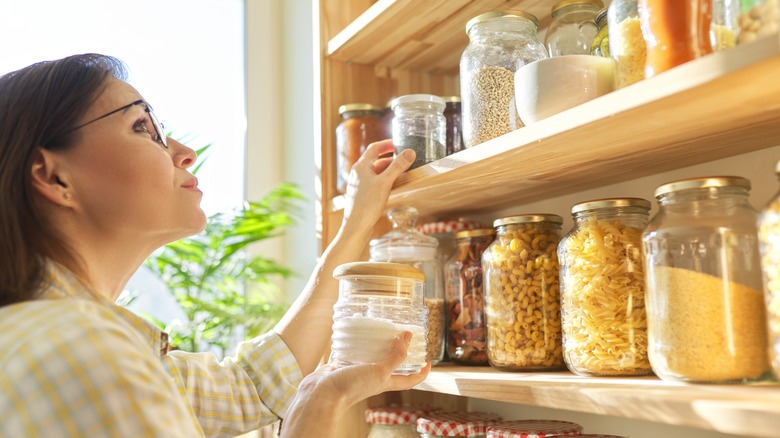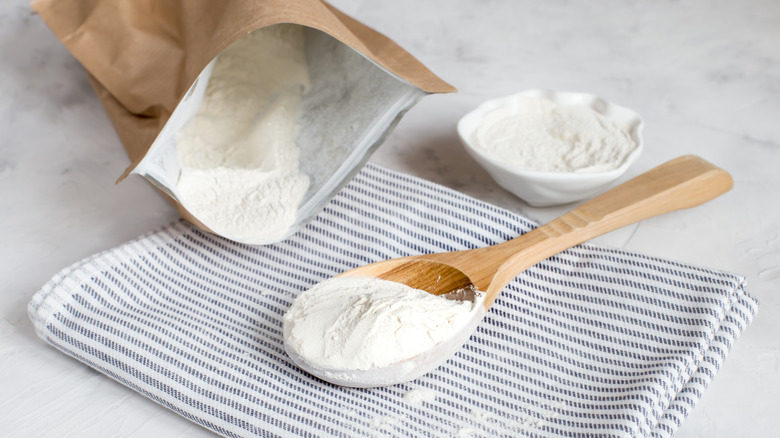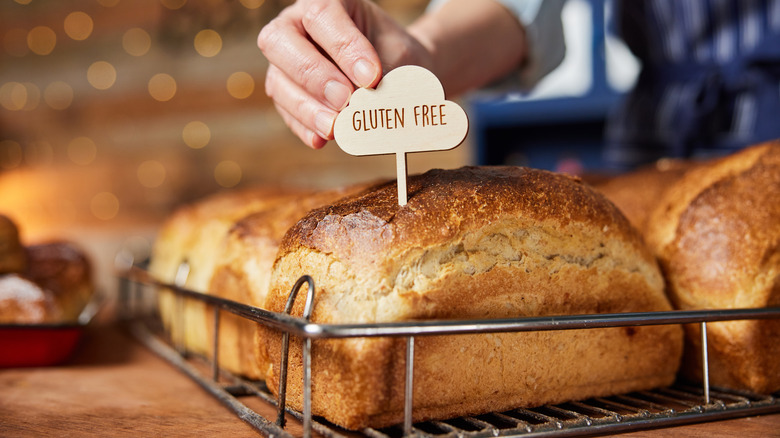This Ingredient Is An Absolute Must-Have For A Gluten Free Pantry
There are a number of reasons to go gluten-free (and a lot of myths about gluten), but the most serious is a diagnosis of celiac disease. That's a condition in which a person's intolerance to gluten results in a whole host of life-threatening medical problems, including an inability to absorb crucial vitamins and nutrients, intestinal damage, and an increased risk of developing heart disease, certain types of cancers, and autoimmune disorders such as diabetes. In other words, it's a huge deal.
The good news is that the availability of gluten-free foods has become widespread in recent years, and so has knowledge about cooking with this particular dietary restriction. Now, there's no need to avoid things like muffins or bread, but that said, it still requires some know-how, a bit of research, and one particular ingredient really comes in handy: Xanthan gum.
Even if you're new to stocking a gluten-free pantry, you've probably heard of xanthan gum. It's used in a ton of commercial products from toothpaste to salad dressing, but what exactly is it, and what does it do? It helps guarantee success in many gluten-free baking projects, not to mention a surprising range of other meals. It's so handy, in fact, that it's possible that even your gluten-loving friends will want to keep some on hand.
What is xanthan gum and what does it do?
Xanthan gum is widely available, comes as a powder, and is the dried and crushed form of a solid substance made from fermented sugar glucose. The bacterium used for the fermentation comes from cabbage and is called Xanthomonas campestris, hence the name. It's also a fairly recent discovery, in the grand scheme of things: It was first found in 1963, and for a bit of a comparison, another key ingredient in baking — yeast — has been used since as far back as ancient Egypt.
Xanthan gum has a variety of uses, because it has a fascinating property: When it's turned into a liquid, it's really, really good for creating a viscous solution capable of distributing other ingredients in a stable way. That makes xanthan gum perfect for adding to products where you want a suspension, like salad dressing, or a thick substance that doesn't separate, like shampoo.
It's pretty neat stuff, and is also incredibly resilient when it comes to temperature, which makes it great for all kinds of cooking. When it's used in baking, it can replace the thickening properties of gluten. That's why it's often found pre-mixed into some gluten-free flours, and when it's included in cake mixes and cookie batter, it helps give the final product a texture that's similar to those made with gluten. Baking isn't the only reason to keep it around, though, and you can use it for much more.
How do you use xanthan gum?
Even if you don't have a gluten-free kitchen, you might find yourself keeping some xanthan gum on hand. It's almost ridiculously useful: Use it to thicken soups and sauces, give your homemade salad dressings a thick, luxurious texture, use it in the smoothest ice cream you've ever made, and even use it in place of gelatin. You can also use it to make a xanthan gum foam, which can add a fun, experimental element to desserts and cocktails. It's also a secret ingredient for making a thick and creamy Italian hot chocolate, which is reason enough to keep some on hand.
When it comes to baking with it, it can get a little technical, but there is a good rule of thumb that you can start with. Add one teaspoon of xanthan gum per cup of flour if you're making something like bread. If it's a more delicate kind of baked good — like cakes — cut that in half.
In some instances, though, you might need even less, so this is one ingredient that can take some experimentation. That's especially true as some tried-and-true baking rules go out the window when you're baking gluten-free, too. For example, over-mixing your cake batter is recommended when you're baking gluten-free, because it can give your final product a more desirable consistency and structure. (Just don't forget to write everything down, so you know what you did when you get it right!)


